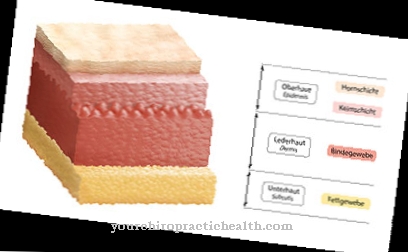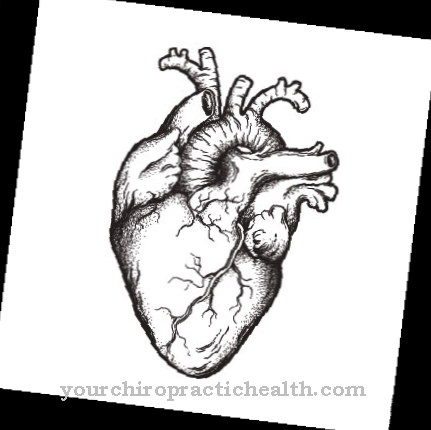Of the Coxitis fugax (Synonyms: Coxalgia fugax, hip runny nose or transient synovitis) especially children are affected. The disease usually subsides on its own after a few days. Consistent rest can relieve symptoms.
What is coxitis fugax?

© elvira fair - stock.adobe.com
The Coxitis fugax is also referred to as Runny nose. Coxitis fugax describes an inflammation of the hip joint that cannot be traced back to germs. Hip runny nose often occurs in children between the ages of four and ten years; Boys are more often affected by the disease than girls.
Typical symptoms of coxitis fugax include sudden hip pain that can extend to the knee. In order to protect the affected knee, patients often experience a temporary limp. Often, when coxitis fugax is present, movement restrictions of the hip can also be observed; It is particularly painful to turn the leg with the help of the hip joint.
causes
In medicine, the exact causes of coxitis fugax are largely unclear.
However, it is known that coxitis fugax was usually preceded by a viral infection that affected the upper respiratory tract (such as the nose and / or the paranasal sinuses) or the gastrointestinal tract, for example.
In most cases of coxitis fugax, a time window of around two weeks is specified between the resolution of a viral infection and the appearance of the first symptoms of the runny nose.
It is therefore assumed by medical professionals that coxitis fugax is not an independent disease, but the consequence of a viral infection.
Symptoms, ailments & signs
In most cases, coxitis fugax does not cause permanent damage or other complications. The disease usually heals on its own, so that treatment is not always necessary. First and foremost, those affected by coxitis fugax suffer from very severe pain in the hip. This pain leads to restricted mobility and also to gait disorders, so that the affected children hobble or limp.
This also significantly limits and slows down the child's development, as the children cannot participate in various activities. These restrictions can also lead to psychological upsets or to depression, which are especially aggravated by bullying or teasing. In general, Coxitis fugax has a very negative effect on the quality of life of the person affected and reduces it.
In some cases, further improper loading can lead to permanent damage, although this occurs relatively rarely. In serious cases, the children are dependent on a walking aid and the help of other people in their everyday life. Here, for example, crutches may be necessary so that the joint is no longer stressed. Coxitis fugax does not adversely affect the patient's life expectancy.
Diagnosis & course
The suspected diagnosis of coxitis fugax can initially be made based on typical symptoms of a patient (such as sudden hip pain and limping).
Since affected patients are mostly children, ultrasound is particularly suitable for checking the suspected diagnosis. If an enlarged joint space that is filled with fluid can be detected via ultrasound, this usually indicates the presence of coxitis fugax.
Advantages of the ultrasound procedure for diagnosing coxitis fugax (especially in children) are that the procedure is not painful and does not cause radiation exposure. It is also possible to determine acute inflammatory processes in the body by taking a blood sample; show up in the blood count of a person affected. but no abnormalities, coxitis fugax can still be present.
Coxitis fugax often resolves on its own after one to two weeks. If there is pain in the hip beyond this period, the patient is probably not suffering from coxitis fugax, but rather another disease or functional impairment.
Complications
In most cases, there are no further complaints or complications with coxitis fugax. If the affected child stays in bed and can relax, the disease will subside by itself. As a rule, the patient's mobility is restricted for a short time. The hips in particular are painful and gait disorders occur, which can be noticed by hobbling.
The quality of life of the patient is restricted and reduced by coxitis fugax. In most cases, the fluid will go away on its own after about two weeks and will not cause further discomfort. During this time, the affected person may have to rely on pain medication. Above all, bed rest and protection of the body have a positive effect on the disease.
It is not uncommon for children to need crutches to move about. If the coxitis fugax does not go away on its own, drugs are used. There are also no further complications. In severe cases, the fluid can also be removed directly by a doctor so that the joint is relieved. There are no consequential damages.
When should you go to the doctor?
Coxitis fugax, also known as hip runny nose, mainly affects children between the ages of four and ten years. The disorder very often resolves on its own after about ten to fourteen days. If the runny nose is clearly identified, doctors often do not take countermeasures immediately, but wait for the disease to progress first. Parents of affected children should still consult a doctor as a precaution if their child shows symptoms that indicate a runny nose. It is characterized by sudden hip pain that often extends to the knees.
To relieve the affected leg, the children then begin to hobble. With coxitis fugax, additional symptoms, especially restricted movement of the hips, occur very often. Rotations of the hip joint are often perceived by children as painful. At this point at the latest, your family doctor or a pediatrician should be called in. Although the cause of the disease is not treated, the doctor can at least prescribe pain medication. In addition, a correct diagnosis is important, as in the event of a hip runny nose it is extremely important that the patient takes care of himself and stays in bed if possible.
Doctors & therapists in your area
Treatment & Therapy
If coxitis fugax has been clearly diagnosed and there are no accompanying illnesses in a person affected, the inflammation is often treated with wait and see; this means that the course of the disease and any improvements are observed first.
Doctors also recommend consistent physical rest during coxitis fugax. Such a rest can be achieved, for example, by a few days of bed rest. The hip can also be spared if you have a cold by using walking aids (colloquially: crutches) while walking during the acute illness.
In addition, the hip can be relieved with coxitis fugax by a so-called extension. The legs are stretched, which causes a slight pull on the hip joint. This pull in turn helps relieve the hip. Depending on the severity of the symptoms of coxitis fugax, medications that have analgesic or anti-inflammatory effects can be prescribed.
If the joint space of the hip joint in an affected patient is filled with a large amount of fluid, it can be useful in individual cases to puncture the hip joint. A puncture for coxitis fugax allows the fluid to escape from the joint, which relieves the pressure on the joint.
Outlook & forecast
Coxitis fugax usually only lasts a few days. Around half of all patients can be discharged from treatment as healthy after one week. The prognosis for the disease is very good and the patient will be free of symptoms after two weeks at the latest. There is a full recovery, which is permanent and therefore without the risk of the symptoms recurring.
The path of healing can be shortened through consistent rest and sufficient rest. Coxitis fugax activates the body's natural self-healing powers. The behavior of the patient is also partly responsible for a quick healing. Medical care is not absolutely necessary.
If the advice and instructions of the doctor are observed, the patient can recover without the administration of medication. Normally, further complications are not to be expected. The motor restrictions are short-lived. Therefore, quality of life and wellbeing quickly improve.
If the pain is severe, pain medication may be taken. These are associated with numerous risks and side effects. There may be sequelae that lead to deterioration in health. Under normal conditions, there is a remission of the side effects upon discontinuation of the drug.
prevention
The occurrence of coxitis fugax is difficult to prevent. A painful worsening of symptoms in the presence of coxitis fugax can, however, be prevented by carefully observing the first symptoms. A quick diagnosis and a quick rest can have a positive effect on the course of symptoms.
Aftercare
Even if coxitis fugax is a self-limiting disease, usually without permanent damage, after-care should be given particular importance shortly after the acute phase. The doctor should be consulted again, especially in the case of a prolonged course in which no improvement in the symptoms has been observed after six to ten days. The CRP, which can be used to estimate the level of inflammation in the body, and a blood count should be ordered here.
Hip sonography should also be performed to assess the joint effusion and its regression after the disease has ended. Differential diagnoses such as Perthes disease or coxitis of bacterial origin should always be reevaluated if symptoms persist or recur in follow-up care. Usually, however, only a short period of rest and relief of the joint is necessary.
Afterwards, patients should, in consultation with the attending physician, fully load the joint again and ensure sufficient movement and exercise. If the rest phase lasts too long, incorrect and relieving postures can be memorized and lead to joint and muscle problems that occur later. Depending on the individual situation, it is advisable to take another x-ray after about three to four months in order to be able to assess the joint space. This should be discussed with the doctor.
You can do that yourself
It is especially important for children to have a strong immune system. Since this only has to develop in the course of life, it helps if it is supported by a vitamin-rich diet, protected clothing and sufficient exercise in the fresh air. One-sided and fatty food should be avoided.
Varied and fiber-rich meals help to protect the organism against viruses or to support the immune system in building up defenses. At the first sign of a viral infection, the child should avoid the cold and places where there are many pathogens.
In the case of coxitis fugax, it also helps if the parents carefully observe and correct incorrect posture of the body. If any abnormalities are found, the advice of a doctor should be sought. As soon as the child puts unilateral stress on the bones or joints or overstrains them, the child can be moved to a better posture with loving tips and advice.
Sports activities help to build up muscles. Sitting, standing or running for too long should be avoided. It is also important to ensure that the child does not carry too much weight. Depending on their stature and body structure, children can take very different levels of stress and the skeletal system is prone to damage.



.jpg)
.jpg)






















